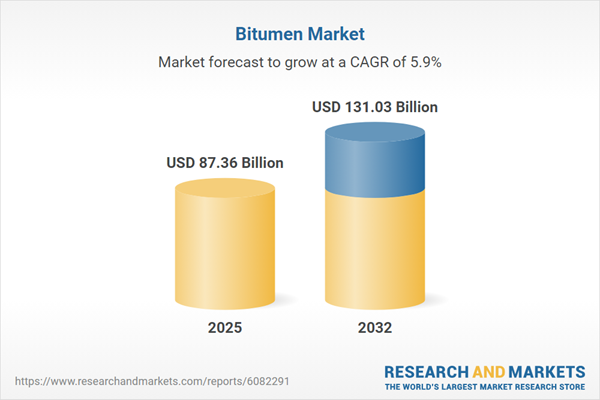Speak directly to the analyst to clarify any post sales queries you may have.
The bitumen market is evolving quickly, led by innovation in production techniques, increasing sustainability demands, and shifting regulatory requirements. Senior executives across infrastructure, manufacturing, and supply chain operations need actionable insight to navigate and capitalize on these developments.
Market Snapshot: Bitumen Market Growth and Outlook
The Bitumen Market registered robust expansion, growing from USD 82.74 billion in 2024 to USD 87.36 billion in 2025. Projected to advance at a compound annual growth rate (CAGR) of 5.91%, the global bitumen sector is expected to reach USD 131.03 billion by 2032. Market expansion is primarily fueled by steady infrastructure investment, rising demand from construction and industrial segments, and technological advancements in bitumen formulation and application.
Scope & Segmentation of the Bitumen Market
This report provides a comprehensive breakdown of the bitumen landscape, offering clarity on critical sub-segments, regional dynamics, and technological adoption:
- Product Types: Commodity bitumen—including emulsions, cutback, oxidized, and paving grade—and specialty bitumen such as blends, additives, crumb rubber modified, industrial, and polymer modified formulations.
- Forms: Liquid and solid forms, addressing diverse application and handling needs.
- Sources: Natural crude-derived origins and synthetic alternatives from refining operations.
- Production Processes: Distillation, oxidation, and solvent extraction methods.
- Grades: Penetration grade, performance grade, and viscosity grade for various performance standards.
- Distribution Channels: Offline networks (direct sales and distributors) and online procurement platforms.
- Applications: Adhesives, sealants, sound and thermal insulation, roadways (including airports, highways, streets), and waterproofing (roof, structural, wall solutions).
- Regions Covered: Americas (with U.S., Canada, Latin America), Europe, Middle East, Africa, and Asia-Pacific (China, India, Japan, Australia, and others).
- Key Players Analyzed: Industry leaders and emerging innovators such as BP PLC, Exxon Mobil Corporation, Shell PLC, Marathon Petroleum Corporation, and a selection of regional companies across all major geographies.
Key Takeaways for Strategic Decision Makers
- Advancements in polymer-modified bitumen and digital manufacturing solutions are redefining product performance and operational efficiency across supply chains.
- Sustainability imperatives are driving adoption of recycled materials and bio-based binders, supported by evolving regulatory frameworks and green infrastructure programs.
- Regional policy changes, such as stricter environmental regulations and incentives for sustainable construction materials, influence supply chain agility and investment priorities.
- Strategic alliances, joint ventures, and vertical integration support feedstock security and enable rapid commercial adoption of next-generation bitumen formulations.
- Product segmentation and strong distribution strategies help companies target high-demand applications and focus on emerging urbanization-driven opportunities, particularly in Asia-Pacific and North America.
- Operational resilience, including modular production and buffer inventories, enhances risk mitigation amid volatile commodity flows and pricing shifts.
Tariff Impact: Assessing U.S. Tariff Policy Effects
New U.S. tariffs on bitumen imports introduced in 2025 have reshaped global supply chains and strategic sourcing. Exporters serving the U.S. reassessed contractual agreements and shifted volumes to alternative regions, increasing competition and impacting global price dynamics. These changes require agile procurement, diversified supplier networks, and robust risk management among buyers and producers.
Methodology & Data Sources
Insights in this report are based on a thorough methodology combining primary interviews with industry experts and secondary data analysis from corporate filings, journals, trade association reports, and government sources. Cross-referencing with third-party analyses and stakeholder workshops ensures actionable, unbiased intelligence validated by sector specialists.
Why This Report Matters
- Empowers senior leaders with clear segmentation and actionable guidance to inform strategic investments and operational decisions in the bitumen value chain.
- Provides a holistic view of emerging technology, sustainability trends, and regional market shifts for proactive planning.
- Delivers targeted insights for capturing market opportunities and managing risks in a rapidly evolving regulatory and demand environment.
Conclusion
As the bitumen sector transitions through regulatory, technological, and policy-driven changes, forward-thinking organizations that embrace innovation, sustainability, and robust supply frameworks will strengthen market positioning and drive long-term value.
Table of Contents
3. Executive Summary
4. Market Overview
7. Cumulative Impact of Artificial Intelligence 2025
Companies Mentioned
The companies profiled in this Bitumen market report include:- Agarwal Industrial Corporation
- BP PLC
- Asia Bitumen
- Asphalt & Bitumen West Company
- Bouygues Group
- Cemex, S.A.B. de C.V.
- Chevron Corporation
- China National Petroleum Corporation
- China Petrochemical Corporation
- ConocoPhillips Company
- ENEOS Holdings, Inc.
- Exxon Mobil Corporation
- Gazprom Group
- GOIL PLC
- Hindustan Petroleum Corporation Limited
- Indian Oil Corporation Limited
- Mangalore Refinery and Petrochemicals limited by ONGC Limited
- Marathon Petroleum Corporation
- Maruti Bitumen Pvt Ltd.
- Moeve
- MOL Hungarian Oil and Gas Company Plc
- NYNAS AB
- PJSC LUKOIL
- RAHA GROUP
- Repsol, S.A.
- Rosneft
- Saudi Arabian Oil Company
- Shell PLC
- TotalEnergies SE
- Tüpraş
- Vivasvanna Exports Private Limited
Table Information
| Report Attribute | Details |
|---|---|
| No. of Pages | 196 |
| Published | November 2025 |
| Forecast Period | 2025 - 2032 |
| Estimated Market Value ( USD | $ 87.36 Billion |
| Forecasted Market Value ( USD | $ 131.03 Billion |
| Compound Annual Growth Rate | 5.9% |
| Regions Covered | Global |
| No. of Companies Mentioned | 32 |









